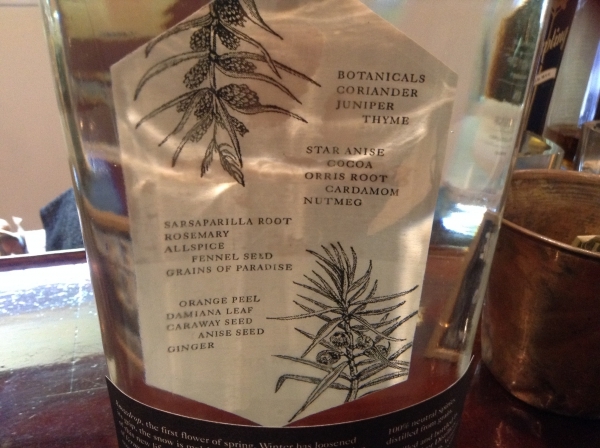BRATTLEBORO — Saxtons River Distillery unveiled its newest product, Snowdrop Gin, during a Brattleboro Area Chamber of Commerce business mixer on June 30.
Named for the “first flower of spring,” the company describes the gin and its 18 botanicals as “an expression of this new life springing from the mountains and valleys of Vermont.”
The botanicals include juniper (a hallmark of gin), coriander, thyme, star anise, orris root, cardamom, nutmeg, sarsaparilla root, rosemary, allspice, fennel seed, grains of paradise, orange peel, damiana leaf, caraway seed, anise seed, and ginger.
Some gins can taste like alcohol that someone waved a juniper berry near. Snowdrop is smooth and its botanicals sit front and center.
“It's a flavorful gin,” Founder and Distiller Christian Stromberg said.
Hand-labeled and hand-numbered bottles from the distillery's first batch are displayed and ready for sampling at the company's Route 30 distillery.
“We're still learning,” Stromberg said. “But with a lot of competition [in the gin market] it has to be good.”
Shape shifter
Saxtons River Distillery's product line includes Sapling Maple Liqueur, Sapling Maple Bourbon, Sapling Maple Rye, and Perc Coffee Liqueur.
In Stromberg's view, gin's versatility intrigues him.
“I think it's an interesting spirit,” he said. “With gin, you can have a lot of fun.”
While juniper is the botanical that defines gin, distillers often mix and match the other ingredients.
Gin's botanicals interact with other flavors, said Marketing and Promotions Manager Drew M. Kacik.
Put gin with citrus and some botanicals will come forward - mix it with tonic water, and different flavors emerge.
Bottles of gin from around the world line the shelves above Stomberg's small lab space.
The gins call many countries home, from large U.K. producers Tanqueray or Bombay to the comparatively smaller Sipsmith, also from the U.K., or Vermont's Barr Hill, or Brooklyn's Greenhook Ginsmiths, or Scotland's Hendrick's Gin, or Monkey 47 from Germany.
Kacik takes bottle after bottle off the shelves. Opening each bottle, he breathes in the aromas. Some have strong notes of juniper. Others, citrus. Some release spicy scents like pepper. In a few, cardamom and lingonberries come to the fore.
Stromberg hopes to harvest as many of Snowdrop's botanical ingredients locally as possible. Some of the botanicals will never be local, such as grains of paradise or cardamom, he said. Others, like juniper, rosemary, and thyme can be sourced nearby.
In the American style
Saxtons River Distillery describes Snowdrop as an American-style, vacuum distilled gin.
American Dry gin, Kacik explains, differs from the popular London Dry gin. By comparison, American Dry tends to have bigger, more complex, and more creative botanical flavors, he said.
Another style of gin, called Old Tom, is sweetened, usually, with honey.
In the production area off the sampling room stands a metal container and pipes that Stromberg built. He jokes the contraption looks more like a small space ship than a 1,000-gallon still. Stromberg affectionately calls the set up “Gin X-1.”
Stromberg said one thing that affects a gin's flavor is how a distiller extracts the aromas and flavors from the botanical ingredients. A popular method is boiling the botanicals in the alcohol.
Stromberg said he tried this but felt the method produced a heavy, “too earthy” gin.
Instead, he has opted for a vacuum distillation process. This method lowers the air pressure in the still. Lower pressure also lowers the alcohol's boiling point. While some gin producers who use vacuum distilling put the botanicals into the alcohol, Stromberg says his botanicals never touch the boiling alcohol, but instead, hang in a basket above. He calls this “vapor infusion.”
In Stromberg's opinion, the resulting gin has a more refined flavor.
Finding the right blend
Alcohol is a solvent and very good at extracting flavors and other qualities from other ingredients, Stromberg said.
According to Stromberg, using vacuum distillation to make gin is “fairly uncommon.”
The distillers at Saxtons River created Snowdrop by blending four distillations. Each distillation contained a different mix of botanicals.
“We're happy with our results,” Stromberg said.
Stromberg started working on the gin approximately eight years ago. The project, however, sat on a back burner for years while Stromberg worked on expanding the business and assembling equipment.
Two years ago, he returned to developing the gin in earnest.
Saxtons River Distillery started 10 years ago in Stromberg's barn. After five years there, the company moved to its current location on Route 30.
For now, Snowdrop only is available at the distillery. Stromberg expects it to be available in stores by August.
